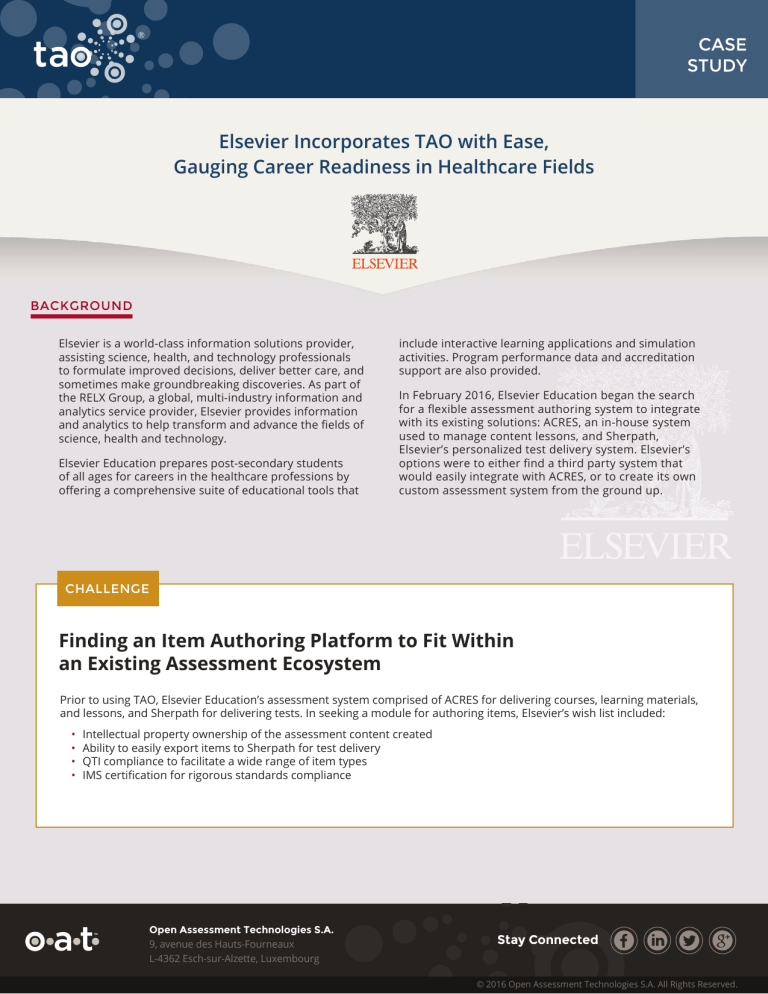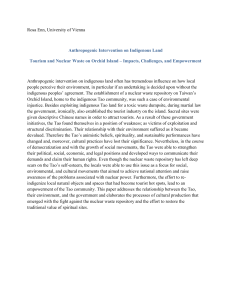Finding an Item Authoring Platform to Fit Within an Existing

CASE
STUDY
Elsevier Incorporates TAO with Ease,
Gauging Career Readiness in Healthcare Fields
BACKGROUND
Elsevier is a world-class information solutions provider, assisting science, health, and technology professionals to formulate improved decisions, deliver better care, and sometimes make groundbreaking discoveries. As part of the RELX Group, a global, multi-industry information and analytics service provider, Elsevier provides information and analytics to help transform and advance the fields of science, health and technology.
Elsevier Education prepares post-secondary students of all ages for careers in the healthcare professions by offering a comprehensive suite of educational tools that include interactive learning applications and simulation activities. Program performance data and accreditation support are also provided.
In February 2016, Elsevier Education began the search for a flexible assessment authoring system to integrate with its existing solutions: ACRES, an in-house system used to manage content lessons, and Sherpath,
Elsevier’s personalized test delivery system. Elsevier’s options were to either find a third party system that would easily integrate with ACRES, or to create its own custom assessment system from the ground up.
CHALLENGE
Finding an Item Authoring Platform to Fit Within an Existing Assessment Ecosystem
Prior to using TAO, Elsevier Education’s assessment system comprised of ACRES for delivering courses, learning materials, and lessons, and Sherpath for delivering tests. In seeking a module for authoring items, Elsevier’s wish list included:
• Intellectual property ownership of the assessment content created
• Ability to easily export items to Sherpath for test delivery
• QTI compliance to facilitate a wide range of item types
• IMS certification for rigorous standards compliance
Open Assessment Technologies S.A.
9, avenue des Hauts-Fourneaux
L-4362 Esch-sur-Alzette, Luxembourg
Stay Connected
© 2016 Open Assessment Technologies S.A. All Rights Reserved.
SOLUTION
Why TAO
After evaluating eight possible solutions, Elsevier selected TAO because of its close match to their requirements. Specifically, TAO offers the following features:
1. TAO makes the disaggregation of content and platform a reality.
This means that Elsevier can create QTI-compliant items using
TAO, and easily export them to Sherpath for test delivery.
2. TAO supports a wide variety of QTI-compliant item types: a total of 17 out of the possible 21 item types are currently available.
This gives Elsevier the freedom to create engaging and interactive test items that can measure student knowledge and skills, and to fine tune the content of the lessons.
3. TAO is a web application based on HTML5, PHP5, and RDF.
It supports multiple data storage solutions like MySQL and
PostgresSQL, as well as NoSQL solutions like Redis and
DynamoDB to allow for greater scalability.
4. OAT, the company behind TAO, plays an active leadership role in IMS Global standards development, and chairs the
Executive Board of Assessment (EBA). The EBA promotes global adoption of online assessments that utilize strong endto-end content and platform interoperability.
“Open Source and freely available code were not initially a must-have for us,” says Mary Millar, Principal Software Engineer at Elsevier.
“However, once we understood how TAO’s Open Source nature gave us maximum integration flexibility, intellectual property ownership, and zero perpetual content licensing fee, we determined that this combination of features made it a perfect fit for our needs.”
CASE
STUDY
RESULTS
Implementing the TAO
Open Source Solution
Elsevier completed the TAO/Sherpath integration in just six weeks. Thanks to an abundance of support and technical documentation, Elsevier required minimal assistance from the TAO engineering team. Notable user-friendly functionalities are built into TAO, including: looping behavior allowing a test-taker to review and change a previously answered item, as well as the ability to pause at the start of a quiz to prompt the student to confirm that he/she is ready to begin.
The pilot in February 2016 involved 3,000 students. Although the lesson content, item bank, and test delivery were each handled by a different system, students had a seamless online experience using a single login – thanks to true interoperability and easy integration.
Since the pilot, Elsevier’s Subject
Matter Experts (SMEs) have created roughly 300 items using TAO. Elsevier is planning a large commercial launch of the system in August 2016, to tens of thousands of students.
“The beauty of TAO is the inherent adaptability of its myriad features,” says
Mary Millar. “Our students had a coherent user experience, despite the reality that we used three different systems. From lesson content to item authoring to test delivery, we were able to rely on TAO for its fluid interoperability and integration. After conducting a broad search, we remain unaware of any platforms other than TAO that can offer this level of usability, flexibility, and freedom through QTI compliance and Open Source.”
Open Assessment Technologies S.A.
9, avenue des Hauts-Fourneaux
L-4362 Esch-sur-Alzette, Luxembourg
Stay Connected
© 2016 Open Assessment Technologies S.A. All Rights Reserved.

